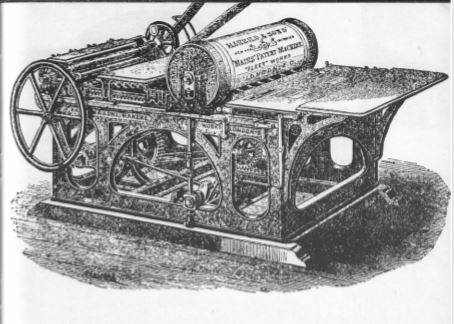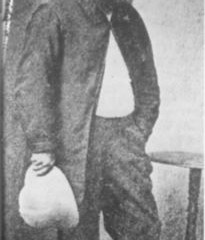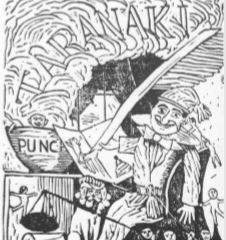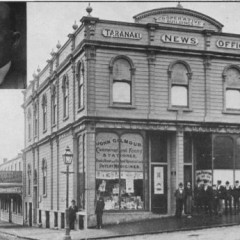8:4
The imposing St Andrew's Presbyterian Church, with its tall, slender spire, was built in 1932 at a cost of $25,000. It is the third building Presbyterians have occupied since an itinerant preacher, John Thom, brought the denomination to New Plymouth in 1858. The first church was built in February, 1866, on a site now occupied by the Farmers' Co-operative building in Devon Street, with R: F. Nicholl sent out by the Church of Scotland as the denomination's first resident minister. The church came to an ignominious end in 1882. The minister at that time was M. S. Breach, an elderly man, who had been 'called' from his parish of Kaipara. In the 10 years he was in New Plymouth there arose division in his adherents' ranks. This came to a head on August 5, 1882, when the Auckland Presbytery decided to discharge Breach from the ministry. Breach agreed to resign and the charge was declared vacant on Sunday, August 13. 'When an unauthorised attempt was made to obtain the key of the church-the windows had been nailed secure against intruders-the trustees at midday on August 18 changed the lock on the door. At 3 p.m. they checked the church, but at 1 o'clock next morning Constable Roche, on his beat, found the church ablaze." The church was burnt to the ground in spite of valiant efforts by brigadesmen. At the inquiry five days later, before a coroner and jury, Breach said that in April of that year he had insured the church and its contents for $800 in his own name.
He had done this without authority, he said, because his stipend was $1200 in arrears; he considered his stipend was a lien on the building. 'I now claim to be entitled to £400 ($800) and to put it in my pocket.' The jury found 'that the Scotch Kirk was wilfully set on fire, but the evidence is not sufficient to implicate any person or persons.' Later Breach, in an 'explanation and defence' in the Taranaki News replying to the Auckland Presbytery's charge that his fire insurance demand had created a grave scandal, said: 'I paid the premium and the money was more than due to me. I have offered the money to the scattered and practical party who have stood by the church for over ten years when they are disposed to act and build themselves at New Plymouth. Not for me, as my preaching days are done.' To the charge that he had slept in St Andrew's at periods before the fire in order to prevent the presbytery getting possession of the church, he replied: 'Only once to relieve the watchman and listen for the coming of those who threaten violence to the building ... now in myoid age I must submit to be hunted into obscurity and a premature grave and then my widow and orphans will be deprived of the blood money.' Next day the Daily News announced: 'The Rev. Somes Breach will
deliver a lecture on Sunday evening in Courtney's Hall on "Is the Presbyterian Church highly demoralised?" , No doubt the attendance will be large. There is no record in the News of the meeting. Without a church, without funds and without a minister, the plight of the Presbyterians was desperate. But the congregation decided to build a new church which was opened on March 2, 1884, with W. Grant, a student, as acting minister. Subsequently a Sunday school and a manse were obtained and by 1913 there was a congregation of 132. The mid-1920s were important for New Plymouth Presbyterians. The denomination's influence increased; the present church was planned, and Fitzroy, Vogeltown and Westown Sunday schools were opened. The new church was completed in 1932, and 24 years later the memorial hall was built, additions to which were completed in 1980. Today the Presbyterian Church in the city has a congregation of more than 600. In common with other denominations, followers of the Baptist Church in New Plymouth had problems which must have seemed insurmount- able. In 1860, when the settlement was in military turmoil, land was bought for the erection of a church on the corner of Liardet and Gill Streets. Because of the hostility from Maoris in the area (which was outside the military compound perimeter) the former owner, T. Kelly, was unable to remove a house on the site and it was not until 1868 that the foundation stone was laid.
In the stone was a bottle containing a parchment bearing the following inscription: 'On the 11th of March 1868 the foundation stone of this chapel, intended for the Baptist denomination, was laid by the Rev. John Whiteley. The building is held in trust by Josiah Flight, William Bayly, G. T. Billing, Richard Hart and George Hoby.' 19 The building was in due time completed, but up to 1878 it had not been opened for divine service. In fact no records exist of it ever having been used, although the Baptists possess letters written to their solicitor, R. G. Hughes, which indicate that it could accommodate 200 worshippers. It is still standing, used as a part of a motor vehicle service station-no doubt with its historic bottle still encased in the foundations.
In an article in the Taranaki Daily News on August 11, 1926, an unnamed writer said: 'After some years the Church ceased to exist, but was resuscitated in 1893.' This is probably correct, for the church records state: 'On October 23, 1893, those attending services formally constituted themselves as members of the church. The meeting was chaired by the Minister, the Rev. Mr Drew, and on the same date the newly constituted church became affiliated with the Baptist Union of Churches of New Zealand.' There were 28 names on the first membership roll. Numbers then increased and in 1909 the minutes contain a reference to the need for a larger building. But it was not until 1913 that a new Baptist Tabernacle was opened in Liardet Street. It was an imposing building, of
ferro-concrete structure in the 'Grecian style,' built by Robert Coleman. Church activities extended and in 1970 a much larger hall and class- rooms were built and a Friendship Club was established to cater for lonely and elderly people.
Seven years later, such was the growth in Baptist membership, the old tabernacle was demolished to be replaced by a new Baptist Church Centre. The official roll in 1980 was about 400, but many more attended services and social and recreational functions.
'SIEGE OF NEW PLYMOUTH. Surrendering of the Enemy. Battle fought. Killed and Wounded. 24 Prisoners Taken. Hallelujah. We opened fire here on 1st March, when Staff-Captain Wright and myself, standing in the Main Street, sang to the eager crowd. "We're travelling Home to Heaven Above." After singing and speaking to the people, we invited them to our Salvation Army Auction room, which was soon crowded to excess with those anxious to hear what we had to say. Firing straight into the ranks of the enemy, many were convinced of sin, but did not yield ... the bells of heaven have been ringing again and again for souls returning from the wild, and we have kept up a continual bombardment of the enemy. The results are that many have been deeply wounded and then healed by the Great Physician ... Knee-drill; time of very great power, both young and old weeping for joy ... ' Thus CaptainJ. E. Newbold, reported in an early issue of the War Cry on 15 March, 1884, of the 'triumphant' entry into New Plymouth of the advance guard of the Salvation Army. Not everyone realised the 'awful doom that awaited them if they continued to sin'. Two years previously, when Captain Wright and Lieutenant Pollard, both teenagers, were commissioned by William Booth, to found the Salvation Army in New Zealand, they were met with some support, but more hostility and ridicule in many of the centres they visited. A Christchurch newspaper said England had sent New Zealand its thistles, sparrows and rabbits; a further scourge was not needed. There was a similar reception for Newbold and Wright in New Plymouth. On the day of their arrival one paper said it was felt that many businesses would lose trade by the Army, which had as its leader a 'self-styled general'. On December 22, 1884, Captain Charles Robinson was prosecuted for defying Section 106, subsection 24, of the New Plymouth Town Council bylaws. This stipulated that 'no person shall cause any obstruction by loitering or standing, after having been requested by any constable to move on.' The captain pleaded not guilty, but the resident magistrate, C. E. Rawson, fined him $2 (costs 90c). A year later Lieutenant Kemp was also in trouble with the law, as a result of which 'a fiddle, concertina and an assortment of instruments' were confiscated. Kemp was fined $10. Later, he was transferred to Hokitika.
In spite of opposition such as this, the' Sallies' won respect, and when
in 1886 a devastating fire razed the block from Currie Street to Brougham Street and Devon Street to Powderham Street, it was the Army which provided food and drink for the firefighters and salvage workers, and which stored many of the rescued goods in its premises, the 'Iron Store,' on the corner of Devon and Currie Streets. Soon there were more than 60 'soldiers' on the roll. The headquarters moved to the Empire Theatre in Devon Street from 1894 until 1923 when a new wooden building was erected at the corner of Brougham and Powderham Streets. During a harvest festival service in 1926 the smell of smoke alarmed the congregation, who found the building was burning. The fire was believed to have been deliberately lit. The Salvationists then moved what property they had to the Workers' Social Hall near the Presbyterian Church until they were able a year later to rebuild their burnt-out citadel in fire-resistant material which remained in use until 1977 when the present $70,000 building near St Joseph's Church was commissioned. During the depression of the 1930s an unused house near the police station was turned into Welcome House, where hundreds of people, regardless of creed, race or sex, found succour. The Army's weekly newspaper, the War Cry , is still sold in public houses, and although in earlier times officers were unwelcome, it still does a brisk trade. One of the best-known sellers was Envoy Stephen Buick, who came to New Plymouth in 1886 when he was 28, having been 'saved' from the drink while in Adelaide, where he joined the Army. He built a small bach which became a home for drunks and dropouts, and for more than 60 years he was a familiar figure, on foot, riding a bicycle and later driving a Model T Ford, delivering the War Cry in town and surrounding country. When he was 94 he was still able to walk up to 20 km a day, and when he died on December 1,1953, the large funeral cortege of people from all walks of life was a tribute not only to Buick but to the work the Salvation Army had done since 1884.
There are several congregations of what the New Zealand Encyc- lopaedia refers to as 'minor religions,' some of which have been established in New Plymouth for many years. Among them is the Open Brethren Assembly, which started early in the 1880s in a building of a farm near the present crematorium. As the congregation increased rooms were rented in the town and in 1915 the Robe Street Chapel was built. Since 1959 Westown adherents have also worshipped in the Gospel Hall, opposite Waimea Street. The Jehovah's Witness movement came to New Plymouth in 1927, and followers held their first meetings in members' houses. In 1960 Kingdom Hall was built in South Road, and has been enlarged and refurbished since, until in 1980 it was valued at more than $100,000
There are no ministers, as such; the affairs of the Witnesses are conducted by appointed elders. Other 'minor' denominations in the city include the Church of Jesus Christ of Latter Day Saints (Mormons); Exclusive Brethren, Seventh Day Adventists, Church of Christ, Assemblies of God, and the Universal Spiritualist Centre, all of which have their own bands of followers.




